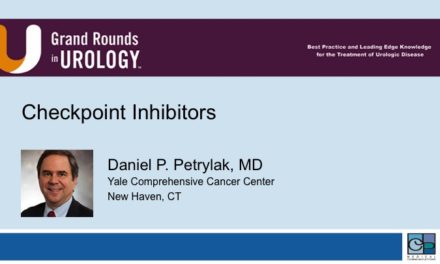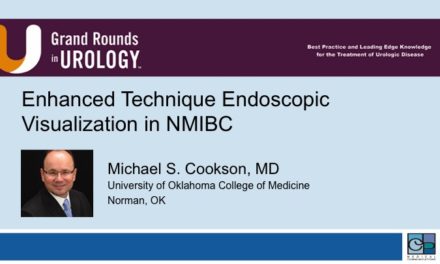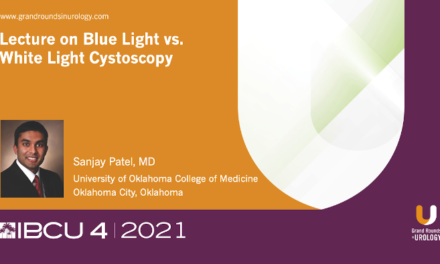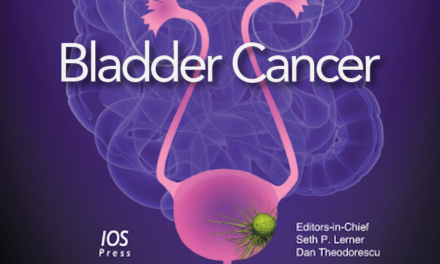Dr. Peter Black presented “Perioperative Pathways: What We Know Works” at the International Bladder Cancer Update meeting on Tuesday, January 24, 2017.
Keywords: bladder cancer, bowel, cystectomy, ERAS, Alvimopan, post-operative, prophylaxis
How to cite: Black, Peter. “Perioperative Pathways: What We Know Works” January 24, 2017. Accessed Apr 2024. https://grandroundsinurology.com/perioperative-pathways-know-works
Transcript
Perioperative Pathways: What We Know Works
What I’m going to talk about here is mostly ERAS, Enhanced Recovery After Surgery, which has become the catchphrase for this topic.
I have to go back here. I just wanted to highlight a potential conflict as a consultant for Merck, which makes alvimopan, which I will discuss as it’s used on label.
So, the topic of perioperative pathways starts primarily with this gentleman Kehlet from Denmark in the late, or in the 1990s, who noted that it would be important to fast-track some patients. So, to get rid of wasteful practices, to standardize practices, try and get us all to treat patients having the same surgery in the same way with the hopes of reducing stress on the patients, which should reduce morbidity of surgery with the hopes of maintaining normal physiology which should enhance recovery. And also, with mobilizing patient’s faster to get them out of the hospital.
And this has subsequently been developed, primarily through colorectal surgery and other domains into the ERAS protocols, Enhanced Recovery After Surgery. This was originally a study group and then a society based I think in the UK, but there’s also very significant Scandinavian presence. And it’s been proven to be beneficial, or ERAS protocols have been proven beneficial in different branches of surgery, including the ones you see there and including of course radical cystectomy.
It makes sense for radical cystectomy. This is a surgery that is associated with a lot of complications, especially GI complications. This leads to long hospital stays and increase in cost. We know that ERAS protocols from these other specialties can decrease stress and promote recovery, so it makes sense to be applying it also in the cystectomy population. Just as a side note, to come back to Sam’s talk on robotics versus open, we may see this as one element in ERAS, but overall it does not, it may not have as great an impact as the whole protocol together.
Fast-track programs were introduced primarily in the U.S. by Sam and the group at Vanderbilt, and also by Raj Pruthi at UNC, and they published on this in the early 2000s, and it was just a way of really standardizing care and getting everybody on the same pathway, and it included pre-op, intra-op, and post-op factors which I’ll come back to.
When we look at current ERAS protocols what I’d like to highlight with this slide is just the fact that it’s many different factors that are all brought together, pre-operative factors, intraoperative, and post-operative. I think there are 22 different things on this slide, and it also includes patient involvement in the blue cloud at the bottom there. So, we’ll come back to some of these factors.
Also, worth highlighting is the fact that it really requires a team approach. So, there are two of us at Vancouver General Hospital that do most of our cystectomies. We are interested in introducing some of these ERAS elements, and it really didn’t work until we had administrative buy-in and a push to get everybody, surgeons, anesthetists, nurses, stoma therapists, everybody committed to the cause, and only then did it work. And it also requires regular audits. It’s an iterative process. You have to see how you’re doing, make sure that you’re meeting the requirements and find out where the deficits are if you’re not.
There have been several studies, most of these are retrospective, just single institutional experiences often comparing a pre-ERAS to post-ERAS, and we will touch on some of these. The slide I showed you had about 22 elements. You’ll notice here in the right-hand most column that these studies have anywhere from just 6 to 14 of those elements. So, they’re not standardized. A lot of them also are based on data from colorectal surgery, and not specifically from bladder cancer or cystectomy data.
The ERAS Society put together these guidelines in 2013, published in the Journal of Clinical Nutrition of all places. There are a couple of urologists in here that we might recognize, like Wes Kassouf, Peter Wiklund, and Hit Patel. And they laid out very nicely, and I want to go through some of these elements. If you look here first of all at the pre-operative elements. There are things that will be familiar to you and that are important. One thing that we probably would not do particularly well without an ERAS program is the preoperative counseling. Of course, it makes sense to optimize medical conditions but also nutrition. Bowel prep can be safely omitted. We’ll come back to that. Oral carbohydrate loading we’ll talk about. That’s something that we have not done in the past. We don’t need the NPO after midnight and a couple of days of clear fluids ahead of time. Clear fluids are actually recommended up until two hours before surgery and solids can be given up until six hours before anesthesia. So, these are important changes that are supposed to promote better outcome, and then we’ll also touch on thrombosis prophylaxis. These are just the preoperative elements.
For nutrition, we know that nutrition, poor nutrition will impact 90-day mortality and even overall survival with major abdominal surgeries, not specifically radical cystectomy. And so, it makes a lot of sense to correct this preoperatively. There have been trials that have looked at, for example, giving everybody TPN after surgery that haven’t really shown a benefit, but if we target those with deficiencies we would expect to see a benefit.
There are different tools to screen for nutritional deficits. This is something very basic that’s a few years old, but it starts with some general questions, and it’s not targeted specifically for surgery, but does your patient have a BMI of less than 20.5? Have they been losing weight? Are they eating poorly? And if so, you can go into a more formal screening. And you see here it’s interesting that if you get three points you’re considered high risk, and if you look at this that the surgery, so radical cystectomy, major abdominal surgery, will already give you two points. If you’re over 70 you already get another point. And so most of our patients are already by definition in the high-risk category from a nutritional point of view.
Prehab, pre-habilitation is a population concept these days coming into vogue. It involves not only nutrition but also functional capacity and physical performance, and there are centers for example in South Hampton and England where they’re actually putting patients on a bicycle machine or ergometer to test their physical fitness before surgery, and then giving targeted exercise interventions to try and enhance their physical capacity. And so, prehab programs in general will involve aerobic and resistance exercises, nutritional counseling, protein supplementation, and I’m not too sure about the relaxation exercises but it sounds good.
As far as bowel prep I think most of us have finally given up on the bowel prep and there’s very good literature again from colorectal surgery. There are also a couple of small trials in the cystectomy world. This is one trial; 62 patients getting cystectomy and urinary diversion, and they’re randomized to three days of standard bowel prep versus actually taking a soft diet, and the bottom line is there’s no increase in morbidity or length of hospital stay, also no advantage, but no safety concerns in any case. And this is another one with 86 patients with a similar outcome.
It is worth mentioning that our colorectal surgeons are now going back to mechanical bowel prep and antibiotics because there’s some evidence that bowel anastomotic integrity may be better. But it does not apply to small bowel. So, we do not need to change what we’re doing with respect to small bowel. Maybe if we’re doing a lot of Indiana pouches or the large bowel surgery it might be relevant. The ERAS Society recommends that we omit bowel prep.
Carb loading; this is something that we struggled with with our anesthetist, even though the literature is very good. It took us a little while to push it through. There is a meta-analysis on 21 randomized studies with about 1,600 patients here who were randomized to an oral carbohydrate, to drink something like apple juice is what we use, given a few hours before surgery versus the classic either nothing or they’re given a placebo, and there was no difference in length of stay if you look at everybody together, but there actually was one-day decreased length of stay in patients who had major abdominal surgery. There was no aspiration and pneumonitis, which is one thing you would in principle worry about, patients aspirating. That’s why we used to have the NPO rule. And there was no increase in complications. So again, this is something that is recommended in patients who are non-diabetic.
Thromboembolic prophylaxis again makes a lot of sense. It has sort of face validity. The evidence in the bladder cancer or cystectomy literature is not great. Jehoni has just talked about this, so I won’t go into detail. But overall, the evidence is very compelling.
This is one very recent publication coming out next month actually in the Journal of Urology, that is retrospective. It’s just the group in Chicago went from an in-house only prophylaxis to a practice of sending patients home with an enoxaparin, and they saw their VTE events go down from 12 to 5%. Those are symptomatic events. it could have been a lot of other things as well. And of course, it’s important to compare the transfusions and blood loss and that appears not to be affected by VTE prophylaxis.
So, what about intra-op? I’m not going to spend as much time on the intra-op factors. These are primarily for anesthesia colleagues. In general, we would like to limit systemic opioids, which usually means a thoracic epidural but it can also mean rectus sheath catheters, which are popular in some locations. Minimally invasive approach for cystectomy we don’t really know if it makes a difference. In principle it’s part of ERAS. Drains can be omitted. That’s the one, this is the one part of the ERAS protocol that we have not adopted. We still leave our drains in the pelvis. Antimicrobial prophylaxis I think we all do. I think one point is that it should not be extended either beyond surgery or certainly not beyond 24 hours. And then there are things for the anesthetist to do, a goal-directed fluid resuscitation is important so patients do not get over hydrated, which is thought to lead to bowel edema and a slow recovery of bowel function.
Now post-op items we’ll also go into some of these in some detail. So, we want to get rid of the nasogastric tube. We do not want our patients having NG tube post-op. I’ll show you data for that. There are things like gum chewing and other measures that help prevent the post-op ileus. We want to be aggressive, treating with metoclopramide or ondansetron, and anti-nausea medications. We actually give scheduled ondansetron not just as needed. We talked a little bit about post-operative analgesia. It’s the same. It should ideally be an epidural or rectus sheath catheters. Things like ketorolac and Tylenol also are important. Early mobilization, that’s the number one thing that’s easy to measure. It’s just to get patients out a day, on post-operative day one after surgery. We start early nutrition but we do not push the amount, so I think it’s important that patients take something, but if they take too much in our experience they will have more nausea and vomiting. And then auditing. Auditing is key, and this is why you need your administration to buy into the process.
The evidence against the NG tube is maybe the most compelling evidence of all in this context. There’s a Cochrane analysis in 2009 that included 37 studies, 37 randomized prospective trials, 5,700 patients, and it was either removal of the NG tube, at least within the first 24 hours, or later than the first 24 hours. It was all open surgery, nothing robotic or lap. It did include some emergent surgery, and they have all of these what do you call these? Forest diagrams looking at the different results. And so, this is for time to first flatus, which was often a primary endpoint in these trials. This little dot here is supposed to indicate that there’s an advantage here for no NG tube with the hazard ratio of 0.51. Again, here pulmonary complications; there is essentially no difference but if anything there’s a little bit of a favor of no NG tube. Wound infections, there’s no difference. Length of hospital stay there’s a little bit of a benefit for no NG tube. Gastric upset, which I think we’d call nausea and vomiting there is an advantage to having an NG tube. This is the only one. Anastomotic leak, no difference. And so, basically the authors of this have concluded that we should stop using an NG tube. It is not meeting any of the goals that we would use it for, and in fact it leads to adverse outcomes. So, I think we’re all clear on this.
Gum chewing is one of these interesting little things that is so easy to do. And there are two trials; one from UNC, one from Korea, one in the context of a fast-track program, one without. So, you wonder would it really make a difference if you’re doing all other 22 things? Is the gum chewing really that important? But again, it’s very easy to do. And overall in these trials patients had a shorter time to flatus and first bowel movement if they were chewing gum, and there was no increased risk of morbidity.
We put this all together just as an example. This is a Swedish group who’ve put it all together and basically have included all of, or most of the factors that I’ve talked about, and then they’ve looked at their outcomes. And this is just a typical study where they have sort of a pre-ERAS and post-ERAS relatively small numbers, 39 pre and 31 post. Operative times of course aren’t going to change. Blood loss was the same. But time to passage of first stool was shorter post-ERAS. NG tube insertion was less. Re-operation the numbers are very small, so there’s no difference there. Length of stay interestingly was no different, but these are relatively long lengths of stay, and you wonder what would happen if it was pushed more aggressively as we do in North America. Readmission was lower. So, there’s some benefit in this trial to the ERAS.
Very similar study from South Hampton in England where I actually visited the group in South Hampton last year. We’ve had a couple of fellows from this program. They were very proud when I was there that they discharged a patient on post-operative day one after a cystectomy, which I don’t necessarily think is our goal. But they introduced an ERAS protocol, and then they sat down in August 2012 and went over all of the details and came out with a version two, new and improved ERAS, and it just shows how you need to review it and improve upon it and enroll that again. And they see differences from one to the next, so especially their length of stay. And you know, some of this may be just the attitude as well of just saying okay we don’t need our patients to stay in the hospital this long, look at the guys across the pond, they’re getting them out in a week. Why can’t we? But also, time to flatus, percent having an ileus. Mean node yield, just to indicate that they’ve actually increased the scope of surgery to some degree without any decrease or any worsening of their surgical outcomes.
And then this is one of the only prospective trials. This is from the group in Munich, Christian Stief’s group, and they have done a two-to-one randomization to ERAS versus a conservative normal usual protocol. They show some real differences in some of these same things, wound healing disorders, thrombosis, etcetera, but interestingly, have also included some quality of life measures. And at different timepoints, day three, day seven, at time of discharge, you see significant improvements in quality of life, which I think is also noteworthy.
Just at the end here I wanted to touch on alvimopan which has come along since basically everything I just showed you. It’s the new kid on the block, so new that it hasn’t been approved by Health Canada, and again I don’t have access to this, but we will soon. The idea is that if patients are getting opioids the opioids are going to have a central effect on pain, but also a peripheral effect on bowel function and would cause an ileus. The alvimopan is a peripheral opioid receptor blocker that will block the GI effects, but will not get into the central nervous system and will not affect pain. And so, it’s been shown very nicely in this radical cystectomy trial, that I’m sure some people in the room are involved with. I think Sam are you part of this? Yeah. And so, this was a nice prospective randomized double-blind trial, placebo versus alvimopan. A dose is given prior to surgery, and then twice a day for a maximum of seven days post-operatively, or of course if they go home it stops when they go home, so a maximum of 15 doses. The primary outcome was GI recovery, which was the later of tolerating a regular diet or having a bowel movement. And basically all of these endpoints are positive on the trial, so GI recovery was sooner, discharge was sooner. This is when the discharge order was written. The post-operative length of stay was clearly shorter. Ten days seems like a long time for the U.S. context. Prolonged length of stay greater than seven days was better, and the morbidity specifically related to ileus was better.
One criticism I would have of this trial is that it excluded patients who had an epidural, which of course is a very common practice, and it was not quite a full ERAS protocol. So, there has been some noise around the country about potentially doing another trial with alvimopan in the context of a formal ERAS protocol.
One study, this is from Sia Daneshmand at USC, has actually compared their pre- and post-ERAS experience, and in the post or with ERAS they actually used alvimopan. So, this is the first study to come out with the alvimopan plus a full ERAS protocol. They had 110 patients. They involved or included most of the usual things with their ERAS, although they do not use an epidural but they use these rectus sheath catheters where you instill local anesthetic right under the fascia of the rectus muscle. They also use neostigmine which I think most of us do not, so that was an additional factor. And they managed to get their length of stay down from eight days to four days. This is doing what they do now compared to historical controls. One other thing they so is that they can have patients come in every other day after surgery for an IV fluid bolus, which is a common cause otherwise for readmission. So, that also contributes. Remarkably they achieve 82% bowel movement by post-operative day two, which we don’t see north of the border.
In conclusion, GI complications are a big deal after cystectomy. It makes a lot of sense to be using ERAS protocols, which I think on balance have been shown to be beneficial in the radical cystectomy population, and we just, if we’re introducing it in our hospitals we really need to get the whole team on board to make it happen. I would like to acknowledge these people because I took some slides from Canadian Urological Association’s slide deck that’s intended as a CME for Canadian urologists. So, just acknowledge the people who put it together with me. Thank you.




